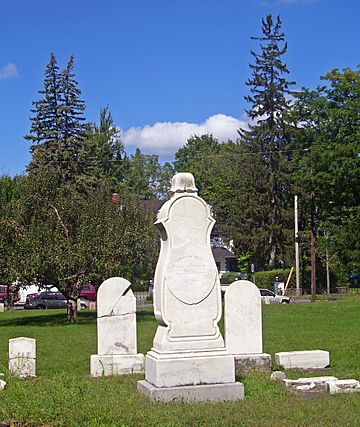Sharp Burial Ground facts for kids

John O'Neil monument and surrounding headstones
|
|
| Lua error in Module:Location_map at line 420: attempt to index field 'wikibase' (a nil value). | |
| Details | |
|---|---|
| Established | 1832 |
| Location |
Albany Ave., Kingston, New York
|
| Country | USA |
| Type | Public |
| Owned by | City of Kingston |
| Size | 1.6 acres (0.6 ha) |
| No. of graves | 186 |
|
Sharp Burial Ground
|
|
| MPS | Albany Avenue, Kingston, Ulster County, New York MPS |
| NRHP reference No. | 02001320 |
| Added to NRHP | November 15, 2002 |
The Sharp Burial Ground, also known as the Albany Avenue Cemetery, is an old cemetery in Kingston, New York, USA. It's located on Albany Avenue (NY 32). This small burial ground was used in the mid-1800s. Back then, bigger cemeteries outside of towns weren't common yet. Also, older churchyards had become too full.
Later, when larger cemeteries opened, many families moved their loved ones' graves to be together. But some important people, like two former members of Congress, are still buried here. The cemetery has cool examples of old gravestone art. For a long time, it was forgotten and fell apart. However, a local group helped clean and fix it up in the 1990s. In 2002, it was added to the National Register of Historic Places. This means it's an important historical site. It's the only cemetery in Ulster County, New York listed on its own.
Contents
Exploring the Cemetery Grounds
The Sharp Burial Ground is on the east side of Albany Avenue. It's a rectangular area about 1.6 acres in size. On one side, it's next to an old railroad path. On the other sides, it's surrounded by homes.
Homes Nearby
The area around the cemetery is mostly residential. Most of the houses were built in the late 1800s. Four other houses in this neighborhood are also listed on the National Register of Historic Places. These include the John Smith House and the Jacob Ten Broeck House.
Inside the Gates
An iron fence with a gate runs along the sidewalk. This fence is new, so it's not part of the original historic cemetery. The ground inside is flat, with some old trees and plants. The gravestones are grouped together in no special order. There isn't a clear plan or grid for where they are placed.
Two large monuments stand out. One is a tall, vase-shaped marker for Edward O'Neil, who helped start the cemetery. The other is an obelisk (a tall, thin, four-sided monument) for Abraham J. Hasbrouck. He was a state lawmaker and a member of the U.S. Congress.
A Look at History
Records show that part of this land was used for burials as early as 1810. But it officially became a cemetery in 1832. That's when Edward O'Neil mapped it out. He planned for 210 graves. The plots at the back were larger, while those at the front were smaller. These front plots were set aside for the main religious groups in town.
Why This Cemetery Was Needed
The Sharp cemetery is an example of burial grounds from its time. Older churchyards from colonial times were getting full. The village of Kingston was growing fast. A very large "rural cemetery" would have taken up too much land. So, burial grounds like Sharp, usually on the edge of town, were a good solution. They were big enough and planned to handle new graves for many years.
Art on the Gravestones
Some of the graves show the art styles popular in the mid-1800s. Edward O'Neil's own grave, from 1856, is shaped like a vase. It has a carved laurel wreath, which symbolizes memory. You can also see symbols like the willow (representing sadness) and the urn (representing the soul) on many graves from this period.
Changes Over Time
The last burials at Sharp happened in the 1870s. By then, bigger cemeteries like Montrepose and Wiltwyck had opened. These were further away from the city. Many families chose to move their relatives' graves from Sharp to family plots in these new, larger cemeteries. About ten years later, a historian named Nathaniel Bartlett Sylvester wrote that the Sharp Burial Ground was "very handsome." But he also noted it seemed to be neglected because so many graves had been moved.
Bringing it Back to Life
The cemetery continued to decline until 1995. That's when the Friends of Historic Kingston (FOHK) stepped in. This local group works to protect historic buildings and sites in the city. They cleaned up the cemetery and fixed the remaining gravestones. The new fence and gate were also added around this time. The FOHK group still helps take care of the cemetery today.
Notable People Buried Here
- Abraham J. Hasbrouck (1773–1845): He was a state assemblyman and a member of the U.S. Congress.
- Jacob H. DeWitt (1784–1867): He also served as a state assemblyman and a congressman. He was also on the county board of supervisors.
- John Van Buren (1799-1855): A U.S. Congressman, a member of the New York State Assembly, and a judge in Ulster County, New York.

